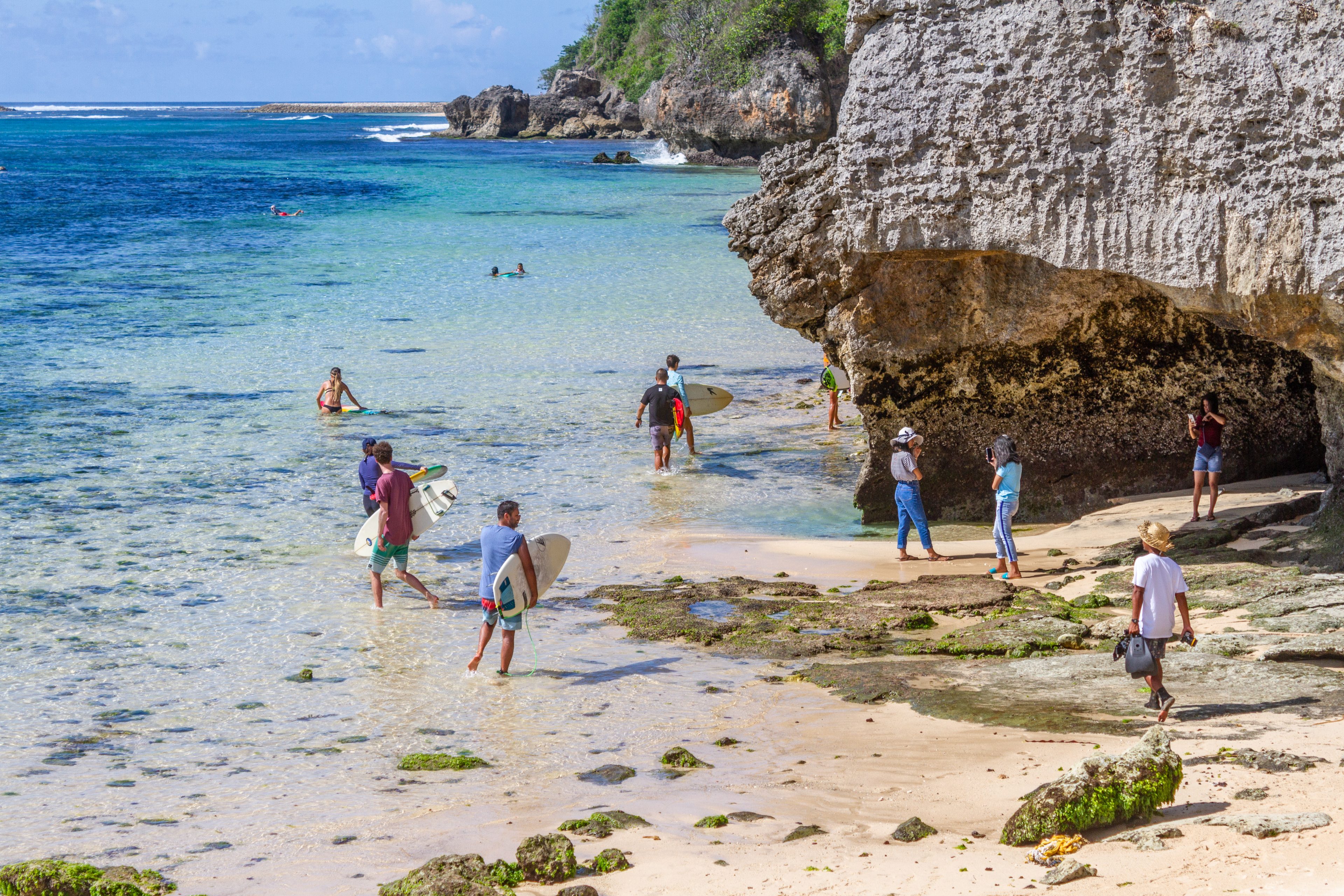
The Complete Guide To Surfing Nusa Dua
Nusa Dua (2 islands in English) was developed as a purpose-built tourism resort in the 1970s and 1980s by the Indonesian government in collaboration with international and local organisations. Nusa Dua’s infrastructure was carefully planned to cater to the needs of international tourists, including the construction of luxury resorts, golf courses, convention centers, and other amenities. The area was designed to provide a safe and controlled environment for travelers, which is why it is a gated community with controlled access points. Nusa Dua is known for its 5 star luxury hotels, pristine white sand beaches, and world-class facilities, making it a popular choice for both leisure and business travelers. In 2022 it was the location for the G20 and regularly hosts prestigious international conferences.
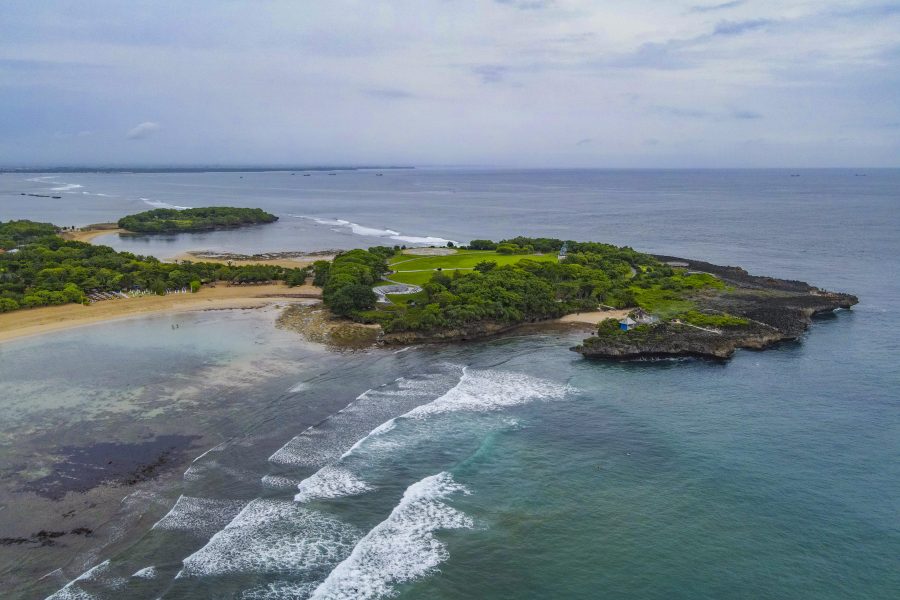
The Bukit (hill in English) is renowned for the quality, quantity consistency and variety of surf breaks in such a small area. In the rainy season, the prevailing winds in Bali often come from the southwest or west, which means that Nusa Dua, is offshore on the leeward side. This results in calmer and less windy conditions on the Nusa Dua beaches, making it a more sheltered and pleasant location during this time. Wind speed on the beach at Nusa Dua is generally about half the strength of more exposed locations, due to the protection from the Bukit (hill) and shoreline buildings.
Getting to any of the Nusa Dua breaks from the surf camp is easy as we are stratgically located for all the Bukit surf breaks. Nusa Dua has many pristine beaches and is the go to location for the surf camp in the rainy season, when it is onshore at the Uluwatu surf breaks.
All of the Nusa Dua surf spots are offshore when Uluwatu is onshore. Depending on the tide and swell size there are various surf spot options for beginner, intermediate and advanced surfers. While Nusa Dua is known as a wet season location, it can also be surfed in the dry season early morning before the trade winds kick in and blow it out around mid-morning.
Read on to learn more about Nusa Dua’s various surf spots and .
1. Nikko
Nikko (also known as Nico beach) is the most southerly of the Nusa Dua surf breaks, located directly in front of the old Nikko hotel, which has been renamed Hilton Bali Resort. Nikko was a secret spot for many years, but was put on the surfing map in 2016 when a jetty was extended into the surf break.
The effect of the jetty is to reduce the size of the surfing area. Previously Nikko was a very long flawless white sand beach that offered a huge area to surf. Now the surfing area has been reduced considerably, but the nature of the wave in the smaller area is very much the same. Nikko is a fast right hander that barrels and works best at mid to high tide.
Not many people surf Nikko since the jetty was built, as the popular view is that the wave is ruined. It is still a good quality wave but for advanced surfers only due to the speed and power of the wave, but many goofy footers find it breaks too fast.
2. Geger left
Geger left is a low tide wave that has become popular recently. It works up until mid tide but at high tide the water is too deep for the wave to break. It is not suitable for beginner surfers due to the strong current and the distance the wave breaks from the shoreline. The end section has a bowl that looks like a Mentawais type wave. This bowling of the wave is caused by the deep water channel – the wave moves at different speeds due to the different depths. When the surf is small, the end section is suitable for intermediate surfers as the wave fattens out in the deep water channel at the end of the wave. It’s a short ride but fun and an easy paddle back out in the channel if you make it to the end of the wave. The better your surfing ability, the deeper you can take off and still make the wave.
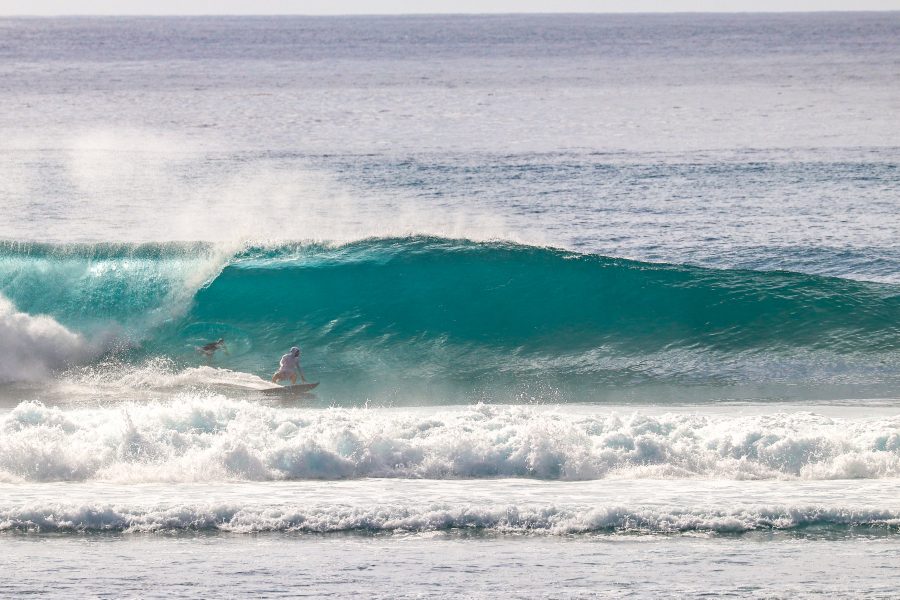
Further north up the reef, towards Geger right, there are various peaks that are fast and shifty. Due to the fast breaking nature of the wave, on big days it is only suitable for advanced surfers. The wave will occasionally barrel and there are some fun sections, but generally it is a short ride that will always close out.
For the paddle out to the break, it’s best to follow the coastline to the south before starting to paddle i.e. take a circuitous route out to the break. Remember to save some energy for the paddle back in, as the current is working against you, and can be a long hard paddle at mid-high tide. Best to head directly towards land coming in, and ideally get a big whitewater wave to push you some of the way towards shore.
3. Geger right
Geger right is located near the Bali National Course and was the go to wave in Nusa dua. When when people talk about surfing Nusa dua, by default they mean Geger right. There is very deep water offshore Geger right which amplifies the swell size. Geger right picks up the most swell on the east coast and is never flat. It can hold huge swells, and is experts only when more than double overhead, due to the risk of clean up sets which can drown you, and strong currents which mean endless paddling.
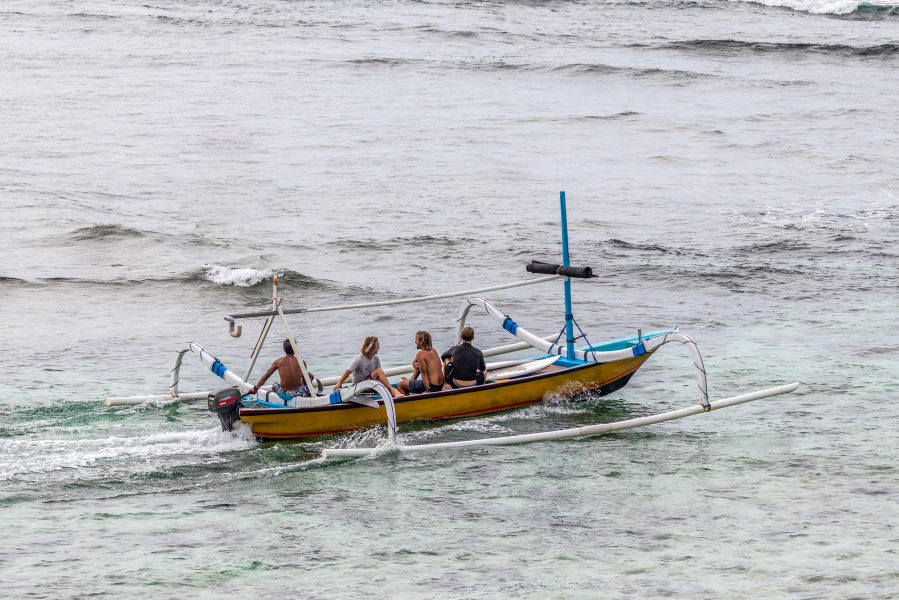
Geger is a high quality performance wave, but the downside is that there is a very strong current working against you so it’s hard to maintain position, and even harder to paddle back after a wave. We only take advanced surfers to Geger right because the current is very strong and it can be very hard to get out the back through the whitewater after riding a wave to the inside. One tactic we employ is to start the session at the first peak in the far south, and work our way down the sections, ending up at Chicken wings. After a long ride it’s very hard work to paddle back to the take off point. A 1 hour session here is like surfing 2 hours anywhere else, and will feel like 3 hours if you get caught inside by a set or two.
Geger right can be surfed at all tides but mid-high tide is best. At low tide you can walk across the reef. When there is enough water we recommend taking a boat to drop you at first peak. Jumping off the boat can be a bit intimidating on a big day as you can see/feel how deep the water is, and it is disorientating at first to know where to line up, as you are accessing the break from the back. If you are very lucky, when paddling from the boat to the line up you will catch a set wave, and ride it all the way to Chicken wings!
4. Chicken wings
Chicken wings is the last section of Geger right and is popular with intermediate surfers. Geger right does not usually link up with chicken wings. There is a deep water section where the wave ridden from Geger right usually fattens out.
Despite the name, Chicken wings is a high quality wave, and very suitable for advanced surfers who want to avoid the much stronger current at Geger. It works best at mid-high tide and is best accessed by taking a boat from Mengiat beach. One way drop from the boat is a good option if you are not sure what time you want to be picked up, as the current moves in the direction back to where you took the boat. The rides at Chicken wings can be very long and if you pick the right wave, it will take you half the way back to Mengiat.
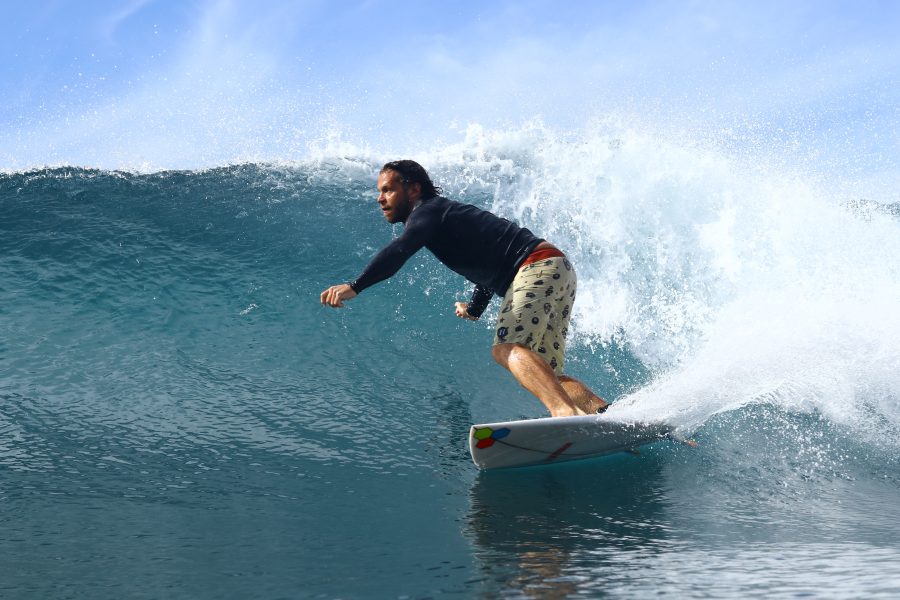
Chicken wings is one of the surf camps’ favourite waves when the wind is blowing westerly or south westerly on a medium sized swell. The current is not as strong as Geger and getting caught inside is not so punishing.
5. Mengiat
Mengiat is very easy to access, and is beautifully located in the middle of a long pristine white sand beach. To access the car park, you enter via a manned gate an area with well-manicured tropical gardens, which is an oasis compared to the bustling streets outside. It is a very short walk from the car park to the surf break.
At mid-tide on the inside there is a section that is suitable for beginner surfers on a small swell. On a bigger swell there is too much current to make it safe for beginners.
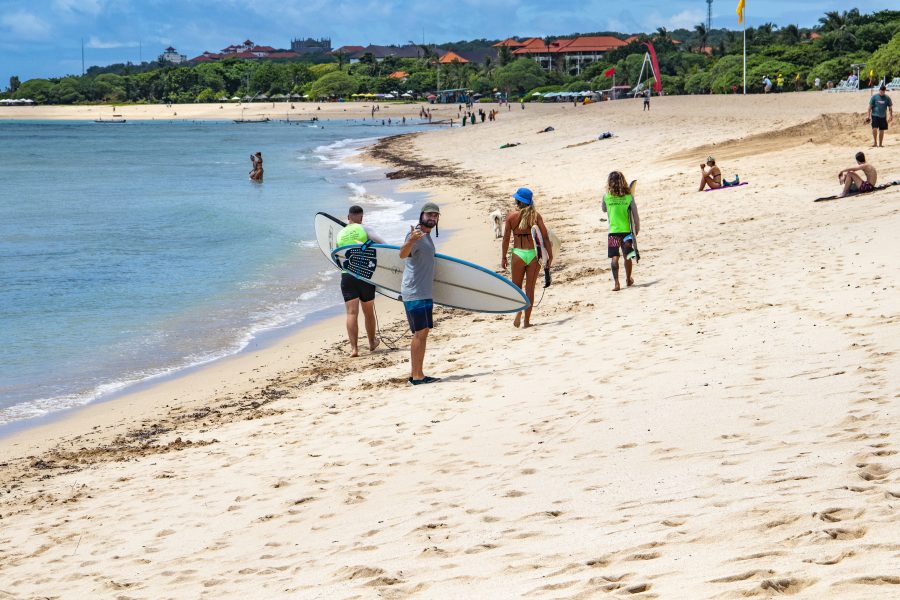
Mengiat breaks both left and right and works best at mid-high tide. It is suitable for intermediate surfers on a small swell and advanced surfers when overhead. The peak is shifty and the left generally works best. There is a current running which adds to the complexity of a difficult take off, and usually the rides are short. The left has an interesting bowl at the end section, where there is a deep water channel. The channel is the easiest spot to paddle out. The waves look perfect from the beach, and when paddling out it looks like a perfect set up, but it is a fast wave and difficult to get in the right position. Mengiat is a fickle wave that does get good, but is usually a bit disappointing.
5. Black stone
Black stone has a peak that forms from the bounce from the island that separates the break from mushroom rock. It can be a very challenging take off, and suitable only for advanced surfers due to the speed that the wave forms and the steepness of the wave. There is a short right hander from this peak, but usually the left offers a longer ride.
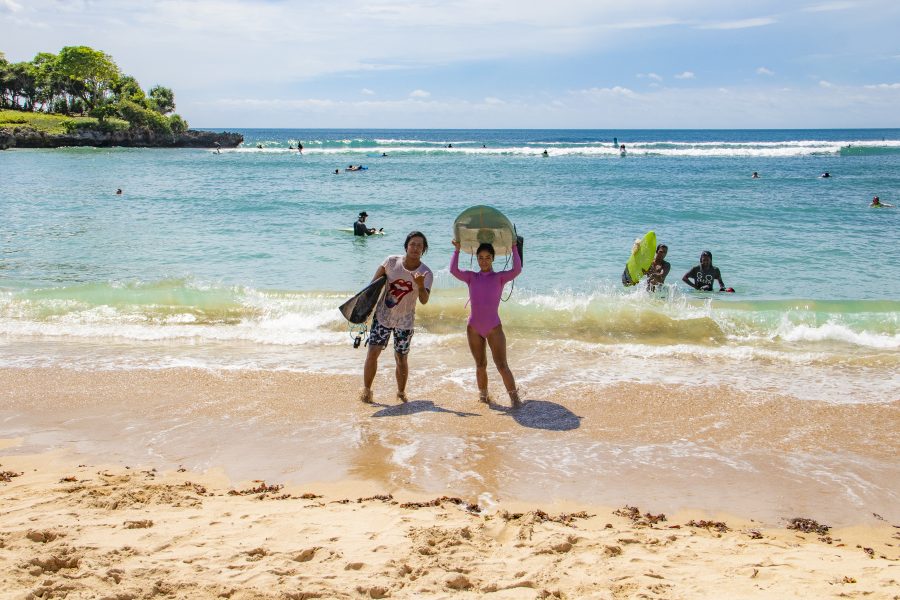
At low tide the wave dumps and is not surfable. It needs a big swell to break at high tide, but the spot does not hold a big swell or high period. Best to surf it at mid tide when the wave period is around 12 or 13 seconds. At high tide on a small swell the water is too deep for the wave to break. High period swells make the wave wonky – best go another spot if swell period is 14 seconds or more.
Black stone can be very good but it is fickle with a tricky take off. On a spring tide, there is a maximum of just 1 hour on the incoming and outgoing tide when the water depth is optimal. Neap tides are best, as the tide stays at mid-tide for much longer and there is less water moving.
Intermediate surfers are usually best to sit on the inside away from the peak as it is a bit more mellow without the bounce from the rock. Another 50 metres south in the direction of Mengiat and there is a spot that is suitable for beginners on a small swell.
6. Mushroom rock
Mushroom rock is a high tide right hand wave that breaks very fast. On the biggest swells it breaks very heavy and is experts only. Most days, it is suitable for intermediate and advanced surfers but many of the waves break too fast for goofy footers. It’s not suitable for beginner surfers due to the distance you must paddle to get to the break, and the whitewater does not run very far – it fattens out in deep water.
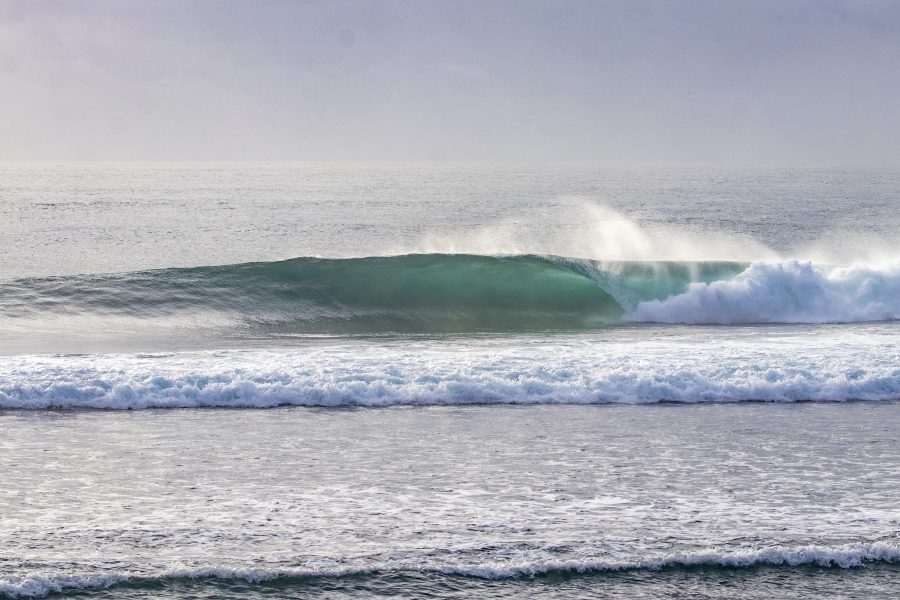
The quickest way to access the break is to jump off the headland that separates mushroom rock and black stone. It’s not particularly difficult for advanced shortboarders to access the water from the rock. For intermediates on fun boards, we recommend they paddle from the beach. It’s not practical to climb up the headland to exit the water, so best to paddle directly to shore after the end of your session.
Mushroom rock is protected from a south westerly wind by the rocky headland. If Mengiat and Black stone are choppy from a cross wind, you will often find Mushroom rock is much cleaner.
7. Mushroom secrets
Mushroom Secrets is located to the north of the second island that gives Nusa Dua it’s name. It is an almost exact copy of Mushroom rock, right hander best at high tide, except that the wave is always smaller and breaks softer.
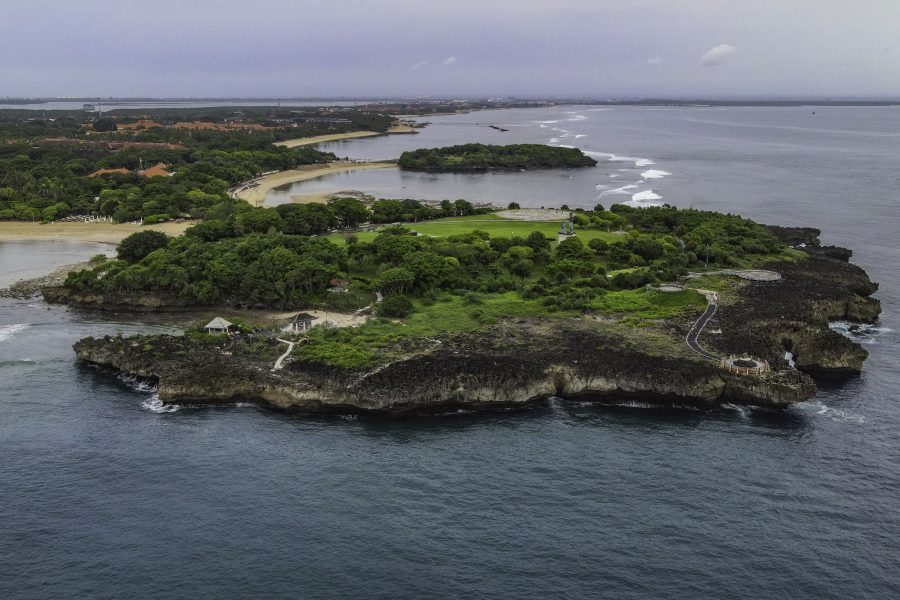
If Mushroom Rock is too big or too crowded it can be worth a walk up the beach to check out Mushroom Secrets which works on the same winds. As the wave breaks softer and slower, this can be a good spot for beginner surfers.
8. Sri Lanka
Sri Lanka is the crème de la crème of all the Nusa Dua surf breaks. Indeed, it is one of the best right handers in Bali and the go-to spot on a big swell in the rainy season. The rainy season usually has smaller swells, so most days, there is not enough swell for Sri Lanka to break well. The best months for Sri Lanka are during the changeover of seasons i.e. March-April and October-November, when you can expect some solid swells and light variable winds.
Sri Lanks needs to be around double overhead on the set waves to break optimally and is suitable only for advanced surfers when there is a decent swell running. It holds triple overhead and bigger and throws huge stand-up barrels. It is comparable to Sunset in Hawaii on the biggest swells.
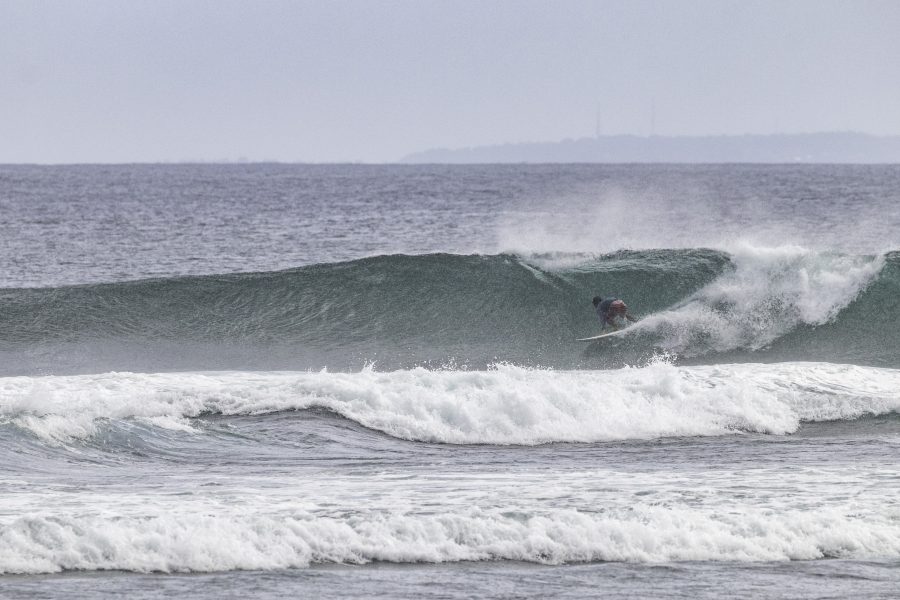
Sri Lanka is a fast take off and you need to angle your board to make the first section. The further up the point you sit, the harder it is to make the first section. The correct place to line up depends on your skill level and if you are goofy/regular – the deeper you go the harder it is to make the first section. Sri Lanks never closes out, as the wave fattens out in a deep water channel. If you hear someone say the wave closed out, it means they took off too deep and/or were not fast enough to make the section. Insider tip: paddle very hard at an angle to get onto the wave and be lined up to make the take off and first section. If you paddle directly for the shore, you will find the wave overtakes you and you will be riding whitewater.
When the wave is head high, then it is suitable for intermediate surfers but any smaller then it does not break properly. If Sri Lanka is smaller than head high, it is better to head south to one of the aforementioned breaks which pick up more swell.
Getting in and out of the water from the jetty is a bit tricky as you need to walk over green slimy stones which are incredibly slippery. If you are not confident slipping and sliding then better to paddle out from the beach. Sri Lanka breaks quite a distance from the shore and for that reason is not suitable for beginners.
Sri Lanka is located directly in front of Club Med and is easy to find. It is within walking distance from Mushroom Rock.
9. Benoa
Benoa needs a big swell to break as it is the furthest spot away from the prevailing swell direction, and picks up the least swell. The spot is a bit hard to find and is about 1km north of Sri Lanka. If you find yourself in a location where there are tourist services such as banana boat rides, you have gone too far and need to head back and look for a small gang (lane/alley) where you can park your bike.
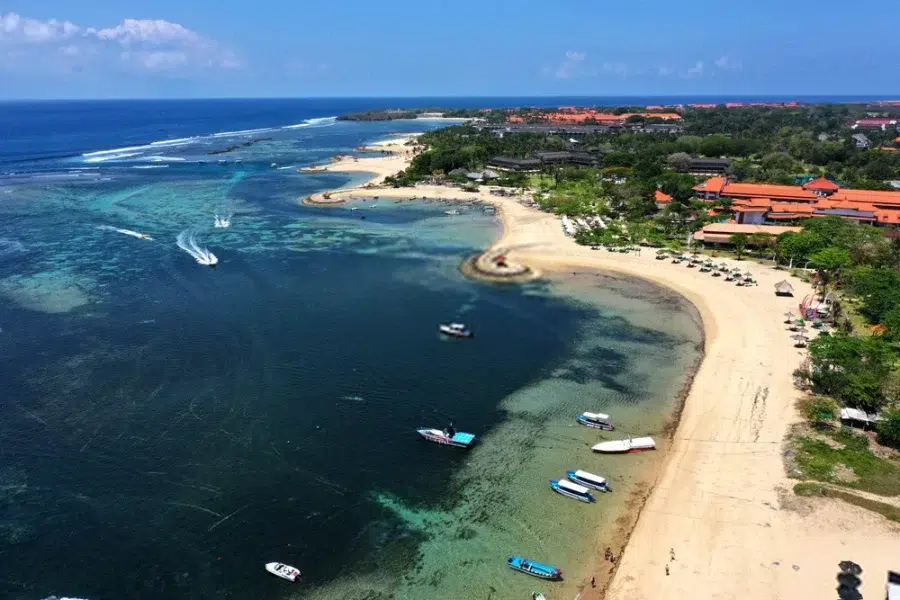
It is best to get a boat to the break, but be warned that some of the boats will only take you half way, and they charge by boat ride, not per person. At low tide you can walk to the spot but a bit challenging without booties. Mid tide, you can wade out most of the way in and out. High tide is a long paddle, and best to get a boat to drop you out the back and pick you up.
Benoa is known as a low tide break but when the swell is big enough it breaks very good at mid tide. On the biggest of swells, it breaks excellent at high tide.
There are 3 seperate surf spots at Benoa. Outside lefts is a shifty bowly peak that gives a very long ride and is best for advanced surfers when more than head and a half high. You don’t want to lose your board here so make sure you have a quality leash. If the outside peak is sizeable, then there is an inside left which is suitable for intermediate surfers. The inside left wave is not the same quality as the outside left, but is easier to access from the shore and breaks softly.
The right hander is a top quality wave and maybe the most underrated wave in Bali. It barrels from take off and it is possible to get a 10 second barrel. Works best at low tide but if the swell is big enough, you can expect big carving walls at high tide. You need to surf Benoa right to appreciate how good a wave this is. You can’t really see it from the shore, and it does not have anywhere near the hype and coverage of Keramas. Everyone who wants a right hand barrel wants to go Keramas and they are welcome to it. We prefer the spots that are just as good, but don’t get the social media coverage and crowds, largely because they are hard to film and access.
When is the best time to surf Nusa Dua?
The best time to surf Nusa Dua is usually during the rainy season from November to March when the wind is predominantly from the west and south west. However, this is also the time when it is more crowded. April and October are excellent months as the winds are generally light and variable and the popular spots such as Uluwatu, Balangan, Padang Padang, Bingin, Dreamland, Impossibles etc are also working, so this spreads the crowds. Insider tip: you can often score Nusa Dua empty in the dry season between May and September. Early mornings, you can be lucky and get no wind, but usually, by around 9 am or 10 am the trade winds will kick in.
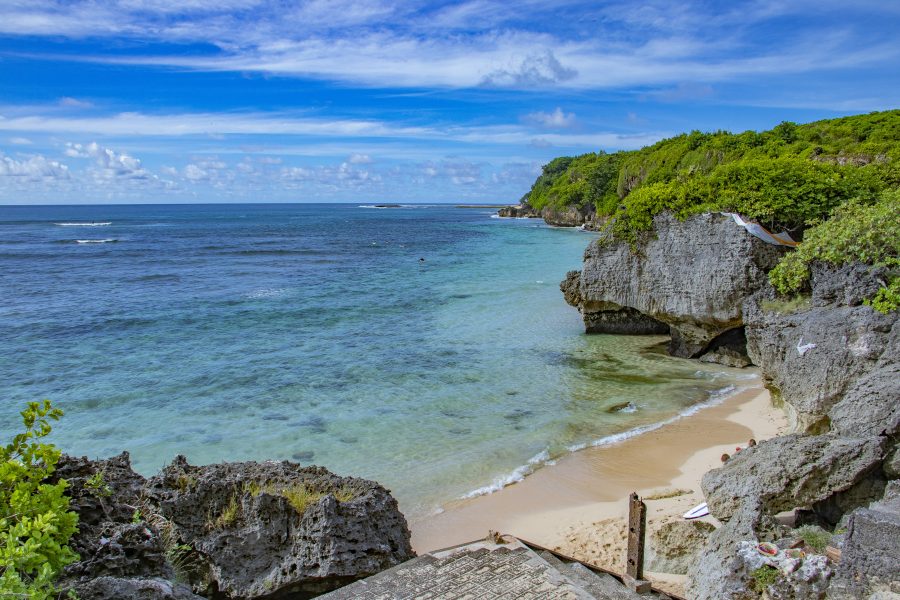
July and August are the worst months because the trade winds are very strong, and it is likely to be windy even at first light. The good thing about Nusa Dua is that it can handle any swell size, and even in the windiest days in January, the wave quality can still be very good as the wind direction will be either direct offshore or cross offshore. Breaks close to the shore such as Black Stone and Mengiat can be best when the wind is howling. Sri Lanka and Mushroom Rock can be best when the wind is cross offshore or sideshore at Geger.
Conclusion
Nusa Dua offer a variety of high-quality advanced waves, intermediate fun waves, and some beginner spots. Geger is never flat and there is always somewhere to surf at Nusa Dua, irrespective of the tide and swell size. The purpose of this guide is to be helpful for you to pick the best spot for your ability on any given day according to the swell size, wind and tide.
Geger holds a big crowd due to the size of the reef. Unfortunately, the same can no longer be said for Nikko, but Nusa Dua has many surf spots in a 6-mile stretch of coastline from Nikko to Benoa.
If you want to discover Nusa Dua and surf the best waves Bali has on any given day, join our surf camp or enroll in our surf school today– as we are strategically located close to all the best surf breaks.